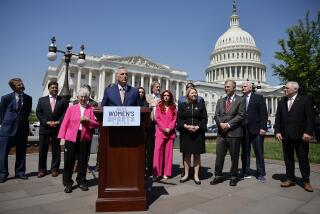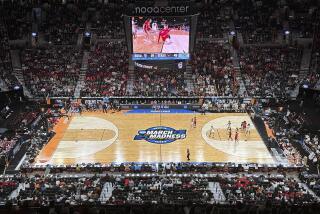College Three-Pointers Could Get Harder : Basketball: Phelps says sentiment of coaches favors moving line back nine inches to international distance.
- Share via
INDIANAPOLIS — College basketball’s three-point shot line may be moved back nine inches next season to the distance used in international competition, Notre Dame Coach Digger Phelps, rules committee chairman for the National Assn. of Basketball Coaches, said Thursday.
An NABC committee will vote on that proposal April 29 in Kansas City, and Phelps says sentiment has strongly turned in favor of extending the three-point stripe from 19 feet 9 inches to 20-6 for colleges and high schools.
Phelps said he sensed a change in mood from Division II and III coaches he informally polled at an NABC meeting Wednesday.
“I think most of us in Division I have wanted this change for the last two years,” he added.
Another possibility would be a stripe nine inches thick, with high school players and/or college women obliged to keep their toes behind the front of this stripe and men behind the back.
One reason for implementing a change, Phelps acknowledged, was the lack of success American teams have been having in international circles, where they are unaccustomed to the longer distance for three-point field goals.
Other reasons he cited included that the balance in college games has shifted too much to the offense; that the shorter three-point distance has not reduced overly physical post play as had been expected and that coaches have taken to positioning three offensive players beyond the line as opposed to two, changing the entire approach to the sport.
“When you see one team taking 53 three-point shots in one game, something is amiss,” Phelps said.
A change also would create a more natural adjustment for collegians to the NBA distance of 23 feet. Phelps pointed out that when a foreign player, such as Drazen Petrovic, appears in an international game after experiencing the NBA, the three-point distance “is like a lay-up.”
Other possible rule changes, including six fouls instead of five for disqualification and a 30-second shot clock as opposed to 45, will be discussed at the NABC meetings here. Phelps saw both changes as inevitable but doubted either would be made by next season.
USC Coach George Raveling, a member of the NABC board of directors, addressed pending legislative changes being discussed, principally the need to “bring sanity” to summer recruitment of student-athletes.
One proposal will be the earmarking of June as a “silent recruiting month,” a so-called blackout period in which there would be no phone calls, correspondence or contact between coaches and athletes, Raveling said.
Another suggestion is to make summer camps more regional and reduce their sparing scholastic players the expense of camps coast to coast and preventing coaches from paying high fees just to show players they care enough about them to be present.
More to Read
Go beyond the scoreboard
Get the latest on L.A.'s teams in the daily Sports Report newsletter.
You may occasionally receive promotional content from the Los Angeles Times.










